Placental Transcriptome Adaptations to Maternal Nutrient Restriction in Sheep
Abstract
:1. Introduction
2. Results
2.1. Model Characteristics
2.2. Differentially Expressed Genes
2.3. Over-Representation Analysis of GO: Molecular Functions
2.4. Transcription Factors Potentially Regulating DEGs
2.5. Gene Set Enrichment Analysis (GSEA) of Hallmark Pathways
2.6. Gene Set Enrichment Analysis (GSEA) of KEGG Pathways
3. Discussion
4. Materials and Methods
4.1. Animal Study and Tissue Collection
4.2. RNA Extraction, Sequencing, and Analyses
5. Conclusions
Author Contributions
Funding
Institutional Review Board Statement
Informed Consent Statement
Data Availability Statement
Conflicts of Interest
References
- DelCurto, H.; Wu, G.; Satterfield, M.C. Nutrition and reproduction: Links to epigenetics and metabolic syndrome in offspring. Curr. Opin. Clin. Nutr. Metab. Care 2013, 16, 385–391. [Google Scholar] [CrossRef]
- Wu, G.; Bazer, F.W.; Wallace, J.M.; Spencer, T.E. Board-invited review: Intrauterine growth retardation: Implications for the animal sciences. J. Anim. Sci. 2006, 84, 2316–2337. [Google Scholar] [CrossRef] [PubMed]
- Balasuriya, C.N.D.; Stunes, A.K.; Mosti, M.P.; Schei, B.; Indredavik, M.S.; Hals, I.K.; Evensen, K.A.I.; Syversen, U. Metabolic outcomes in adults born preterm with very low birthweight or small for gestational age at term: A cohort study. J. Clin. Endocrinol. Metab. 2018, 103, 4437–4446. [Google Scholar] [CrossRef] [PubMed] [Green Version]
- Hochberg, Z.; Feil, R.; Constancia, M.; Fraga, M.; Junien, C.; Carel, J.-C.; Boileau, P.; Le Bouc, Y.; Deal, C.L.; Lillycrop, K.; et al. Child health, developmental plasticity, and epigenetic programming. Endocr. Rev. 2010, 32, 159–224. [Google Scholar] [CrossRef] [PubMed]
- Edwards, A.K.; McKnight, S.M.; Askelson, K.; McKnight, J.; Dunlap, K.A.; Satterfield, M.C. Adaptive responses to maternal nutrient restriction alter placental transport in ewes. Placenta 2020, 96, 1–9. [Google Scholar] [CrossRef] [PubMed]
- Edwards, A.K.; Dunlap, K.A.; Spencer, T.E.; Satterfield, M.C. Identification of pathways associated with placental adaptation to maternal nutrient restriction in sheep. Genes 2020, 11, 9. [Google Scholar] [CrossRef] [PubMed]
- Alexander, G. Studies on the placenta of the sheep (Ovis aries): Placental size. J. Reprod. Fertil. 1964, 7, 289–305. [Google Scholar] [CrossRef] [Green Version]
- Dunlap, K.; Brown, J.; Keith, A.; Satterfield, M. Factors controlling nutrient availability to the developing fetus in ruminants. J. Anim. Sci. Biotechnol. 2015, 6, 1–10. [Google Scholar] [CrossRef] [Green Version]
- Lambo, C.A.; Edwards, A.K.; Bazer, F.W.; Dunlap, K.; Satterfield, M.C. Development of a surgical procedure for removal of a placentome from a pregnant ewe during gestation. J. Anim. Sci. Biotechnol. 2020, 11, 1–7. [Google Scholar] [CrossRef]
- Steinhauser, C.B.; Askelson, K.; Lambo, C.A.; Hobbs, K.C.; Bazer, F.W.; Satterfield, M.C. Lipid metabolism is altered in maternal, placental, and fetal tissues of ewes with small for gestational age fetuses. Biol. Reprod. 2021, 104, 170–180. [Google Scholar] [CrossRef]
- Steinhauser, C.; Askelson, K.; Hobbs, K.; Bazer, F.; Satterfield, M. Maternal nutrient restriction alters thyroid hormone dynamics in placentae of sheep having small for gestational age fetuses. Domest. Anim. Endocrinol. 2021, 77, 106632. [Google Scholar] [CrossRef]
- Sandoval, C.; Lambo, C.; Beason, K.; Dunlap, K.; Satterfield, M. Effect of maternal nutrient restriction on skeletal muscle mass and associated molecular pathways in SGA and Non-SGA sheep fetuses. Domest. Anim. Endocrinol. 2020, 72, 106443. [Google Scholar] [CrossRef] [PubMed]
- Sandoval, C.; Askelson, K.; Lambo, C.; Dunlap, K.; Satterfield, M. Effect of maternal nutrient restriction on expression of glucose transporters (SLC2A4 and SLC2A1) and insulin signaling in skeletal muscle of SGA and Non-SGA sheep fetuses. Domest. Anim. Endocrinol. 2021, 74, 106556. [Google Scholar] [CrossRef]
- Chassen, S.S.; Ferchaud-Roucher, V.; Palmer, C.; Li, C.; Jansson, T.; Nathanielsz, P.W.; Powell, T.L. Placental fatty acid transport across late gestation in a baboon model of intrauterine growth restriction. J. Physiol. 2020, 598, 2469–2489. [Google Scholar] [CrossRef] [PubMed]
- Chen, Y.-H.; Fu, L.; Hao, J.-H.; Yu, Z.; Zhu, P.; Wang, H.; Xu, Y.-Y.; Zhang, C.; Tao, F.-B.; Xu, D.-X. Maternal vitamin D deficiency during pregnancy elevates the risks of small for gestational age and low birth weight infants in Chinese population. J. Clin. Endocrinol. Metab. 2015, 100, 1912–1919. [Google Scholar] [CrossRef]
- Stenhouse, C.; Halloran, K.M.; Newton, M.G.; Gaddy, D.; Suva, L.J.; Bazer, F.W. Novel mineral regulatory pathways in ovine pregnancy: II. Calcium-binding proteins, calcium transporters, and vitamin D signaling. Biol. Reprod. 2021, 105, 232–243. [Google Scholar] [CrossRef]
- Tamblyn, J.A.; Hewison, M.; Wagner, C.L.; Bulmer, J.N.; Kilby, M.D. Immunological role of vitamin D at the maternal–fetal interface. J. Endocrinol. 2015, 224, R107–R121. [Google Scholar] [CrossRef] [Green Version]
- Liu, N.Q.; Kaplan, A.; Lagishetty, V.; Ouyang, Y.B.; Ouyang, Y.; Simmons, C.F.; Equils, O.; Hewison, M. Vitamin D and the regulation of placental inflammation. J. Immunol. 2011, 186, 5968–5974. [Google Scholar] [CrossRef] [Green Version]
- Schröder-Heurich, B.; Springer, C.J.P.; Von Versen-Höynck, F. Vitamin D effects on the immune system from periconception through pregnancy. Nutrients 2020, 12, 1432. [Google Scholar] [CrossRef] [PubMed]
- Aranow, C. Vitamin D and the immune system. J. Investig. Med. 2011, 59, 881–886. [Google Scholar] [CrossRef] [Green Version]
- Etzerodt, A.; Moestrup, S.K. CD163 and inflammation: Biological, diagnostic, and therapeutic aspects. Antioxid. Redox Signal. 2013, 18, 2352–2363. [Google Scholar] [CrossRef] [Green Version]
- Houser, B.; Tilburgs, T.; Hill, J.; Nicotra, M.; Strominger, J. Two unique human decidual macrophage populations. J. Immunol. 2011, 186, 2633–2642. [Google Scholar] [CrossRef] [Green Version]
- Balogh, G.; De Boland, A.R.; Boland, R.; Barja, P. Effect of 1,25(OH)2-vitamin D3 on the activation of natural killer cells: Role of protein kinase c and extracellular calcium. Exp. Mol. Pathol. 1999, 67, 63–74. [Google Scholar] [CrossRef]
- Liu, Y.; Gao, S.; Zhao, Y.; Wang, H.; Pan, Q.; Shao, Q. Decidual natural killer cells: A good nanny at the maternal-fetal interface during early pregnancy. Front. Immunol. 2021, 12, 663660. [Google Scholar] [CrossRef]
- Ota, K.; Dambaeva, S.; Han, A.R.; Beaman, K.; Gilman-Sachs, A.; Kwak-Kim, J. Vitamin D deficiency may be a risk factor for recurrent pregnancy losses by increasing cellular immunity and autoimmunity. Hum. Reprod. 2014, 29, 208–219. [Google Scholar] [CrossRef] [PubMed] [Green Version]
- Mora, J.R.; Iwata, M.; Von Andrian, U.H. Vitamin effects on the immune system: Vitamins A and D take centre stage. Nat. Rev. Immunol. 2008, 8, 685–698. [Google Scholar] [CrossRef] [Green Version]
- Ota, K.; Dambaeva, S.; Kim, M.W.-I.; Han, A.R.; Fukui, A.; Gilman-Sachs, A.; Beaman, K.; Kwak-Kim, J. 1,25-dihydroxy-vitamin D3 regulates NK-cell cytotoxicity, cytokine secretion, and degranulation in women with recurrent pregnancy losses. Eur. J. Immunol. 2015, 45, 3188–3199. [Google Scholar] [CrossRef] [PubMed]
- Herrmann-Hoesing, L.M.; White, S.N.; Kappmeyer, L.S.; Herndon, D.R.; Knowles, D.P. Genomic analysis of Ovis aries (Ovar) MHC class IIa loci. Immunogenetics 2008, 60, 167–176. [Google Scholar] [CrossRef] [PubMed]
- Schwartz, J.C.; Gibson, M.S.; Heimeier, D.; Koren, S.; Phillippy, A.; Bickhart, D.; Smith, T.P.L.; Medrano, J.F.; Hammond, J.A. The evolution of the natural killer complex: A comparison between mammals using new high-quality genome assemblies and targeted annotation. Immunogenetics 2017, 69, 255–269. [Google Scholar] [CrossRef] [Green Version]
- Jansson, N.; Pettersson, J.; Haafiz, A.; Ericsson, A.; Palmberg, I.; Tranberg, M.; Ganapathy, V.; Powell, T.L.; Jansson, T. Down-regulation of placental transport of amino acids precedes the development of intrauterine growth restriction in rats fed a low protein diet. J. Physiol. 2006, 576, 935–946. [Google Scholar]
- Malandro, M.S.; Beveridge, M.J.; Kilberg, M.S.; Novak, D.A. Effect of low-protein diet-induced intrauterine growth retardation on rat placental amino acid transport. Am. J. Physiol. Physiol. 1996, 271, C295–C303. [Google Scholar] [CrossRef] [PubMed]
- Pantham, P.; Rosario, F.J.; Weintraub, S.T.; Nathanielsz, P.W.; Powell, T.L.; Li, C.; Jansson, T. Down-regulation of placental transport of amino acids precedes the development of intrauterine growth restriction in maternal nutrient restricted baboons. Biol. Reprod. 2016, 95, 98. [Google Scholar] [CrossRef] [PubMed]
- Satterfield, M.C.; Bazer, F.W.; Spencer, T.E.; Wu, G. Sildenafil citrate treatment enhances amino acid availability in the conceptus and fetal growth in an ovine model of intrauterine growth restriction. J. Nutr. 2010, 140, 251–258. [Google Scholar] [CrossRef]
- Tiedje, K.E.; Stevens, K.; Barnes, S.; Weaver, D. β-Alanine as a small molecule neurotransmitter. Neurochem. Int. 2010, 57, 177–188. [Google Scholar] [CrossRef]
- Zhang, X.; Yang, W.; Wang, J.; Meng, Y.; Guan, Y.; Yang, J. FAM3 gene family: A promising therapeutical target for NAFLD and type 2 diabetes. Metabolism 2018, 81, 71–82. [Google Scholar] [CrossRef] [PubMed] [Green Version]
- Peiris, H.; Mitchell, M. The expression and potential functions of placental myostatin. Placenta 2012, 33, 902–907. [Google Scholar] [CrossRef]
- Peiris, H.; Georgiou, H.; Lappas, M.; Kaitu’U-Lino, T.; Salomón, C.; Vaswani, K.; Rice, G.E.; Mitchell, M.D. Expression of myostatin in intrauterine growth restriction and preeclampsia complicated pregnancies and alterations to cytokine production by first-trimester placental explants following myostatin treatment. Reprod. Sci. 2015, 22, 1202–1211. [Google Scholar] [CrossRef]
- Shen, P.; Gong, Y.; Wang, T.; Chen, Y.; Jia, J.; Ni, S.; Zhou, B.; Song, Y.; Zhang, L.; Zhou, R. Expression of osteoprotegerin in placenta and its association with preeclampsia. PLoS ONE 2012, 7, e44340. [Google Scholar] [CrossRef] [Green Version]
- Huang, B.; Zhu, W.; Zhao, H.; Zeng, F.; Wang, E.; Wang, H.; Chen, J.; Li, M.; Huang, C.; Ren, L.; et al. Placenta-derived osteoprotegerin is required for glucose homeostasis in gestational diabetes mellitus. Front. Cell Dev. Biol. 2020, 8, 563509. [Google Scholar] [CrossRef]
- Carroll, T.J.; Park, J.-S.; Hayashi, S.; Majumdar, A.; McMahon, A.P. Wnt9b plays a central role in the regulation of mesenchymal to epithelial transitions underlying organogenesis of the mammalian urogenital system. Dev. Cell 2005, 9, 283–292. [Google Scholar] [CrossRef] [PubMed] [Green Version]
- Bhatia, R.; Gautam, S.K.; Cannon, A.; Thompson, C.; Hall, B.R.; Aithal, A.; Banerjee, K.; Jain, M.; Solheim, J.C.; Kumar, S.; et al. Cancer-associated mucins: Role in immune modulation and metastasis. Cancer Metastasis Rev. 2019, 38, 223–236. [Google Scholar] [CrossRef]
- Amabebe, E.; Anumba, D.O. The transmembrane G protein-coupled CXCR3 receptor-ligand system and maternal fetal allograft rejection. Placenta 2021, 104, 81–88. [Google Scholar] [CrossRef] [PubMed]
- Igarashi, H.; Uemura, M.; Hiramatsu, R.; Hiramatsu, R.; Segami, S.; Pattarapanawan, M.; Hirate, Y.; Yoshimura, Y.; Hashimoto, H.; Higashiyama, H.; et al. Sox17 is essential for proper formation of the marginal zone of extraembryonic endoderm adjacent to a developing mouse placental disk. Biol. Reprod. 2018, 99, 578–589. [Google Scholar] [CrossRef] [PubMed]
- Yiallourides, M.; Sébert, S.P.; Wilson, V.; Sharkey, D.; Rhind, S.M.; Symonds, M.E.; Budge, H.; Yiallourides, M.; Sébert, S.P.; Wilson, V.; et al. The differential effects of the timing of maternal nutrient restriction in the ovine placenta on glucocorticoid sensitivity, uncoupling protein 2, peroxisome proliferator-activated receptor-γ and cell proliferation. Reproduction 2009, 138, 601–608. [Google Scholar] [CrossRef] [PubMed] [Green Version]
- Shalom-Barak, T.; Zhang, X.; Chu, T.; Schaiff, W.T.; Reddy, J.K.; Xu, J.; Sadovsky, Y.; Barak, Y. Placental PPARγ regulates spatiotemporally diverse genes and a unique metabolic network. Dev. Biol. 2012, 372, 143–155. [Google Scholar] [CrossRef] [Green Version]
- Rosmarin, A.G.; Resendes, K.K.; Yang, Z.; McMillan, J.N.; Fleming, S.L. GA-binding protein transcription factor: A review of GABP as an integrator of intracellular signaling and protein-protein interactions. Blood Cells Mol. Dis. 2004, 32, 143–154. [Google Scholar] [CrossRef]
- Seuter, S.; Neme, A.; Carlberg, C. ETS transcription factor family member GABPA contributes to vitamin D receptor target gene regulation. J. Steroid Biochem. Mol. Biol. 2018, 177, 46–52. [Google Scholar] [CrossRef]
- National Research Council. Nutrient Requirements of Small Ruminants: Sheep, Goats, Cervids, and New World Camelids; The National Academies Press: Washington, DC, USA, 2007; p. 384. [Google Scholar]
- Lassala, A.; Bazer, F.W.; Cudd, T.A.; Datta, S.; Keisler, D.; Satterfield, M.C.; Spencer, T.; Wu, G. Parenteral administration of L-arginine prevents fetal growth restriction in undernourished ewes. J. Nutr. 2010, 140, 1242–1248. [Google Scholar] [CrossRef]
- Kim, D.; Langmead, B.; Salzberg, S.L. HISAT: A fast spliced aligner with low memory requirements. Nat. Methods 2015, 12, 357–360. [Google Scholar] [CrossRef] [Green Version]
- Liao, Y.; Smyth, G.K.; Shi, W. FeatureCounts: An efficient general purpose program for assigning sequence reads to genomic features. Bioinformatics 2014, 30, 923–930. [Google Scholar] [CrossRef] [Green Version]
- Robinson, M.D.; McCarthy, D.J.; Smyth, G.K. EdgeR: A Bioconductor package for differential expression analysis of digital gene expression data. Bioinformatics 2010, 26, 139–140. [Google Scholar] [CrossRef] [PubMed] [Green Version]
- Chen, J.; Bardes, E.E.; Aronow, B.J.; Jegga, A.G. ToppGene Suite for gene list enrichment analysis and candidate gene prioritization. Nucleic Acids Res. 2009, 37, W305–W311. [Google Scholar] [CrossRef]
- Subramanian, A.; Tamayo, P.; Mootha, V.K.; Mukherjee, S.; Ebert, B.L.; Gillette, M.A.; Paulovich, A.; Pomeroy, S.L.; Golub, T.R.; Lander, E.S.; et al. Gene set enrichment analysis: A knowledge-based approach for interpreting genome-wide expression profiles. Proc. Natl. Acad. Sci. USA 2005, 102, 15545–15550. [Google Scholar] [CrossRef] [PubMed] [Green Version]
- Luo, W.; Brouwer, C. Pathview: An R/Bioconductor package for pathway-based data integration and visualization. Bioinformatics 2013, 29, 1830–1831. [Google Scholar] [CrossRef] [PubMed] [Green Version]
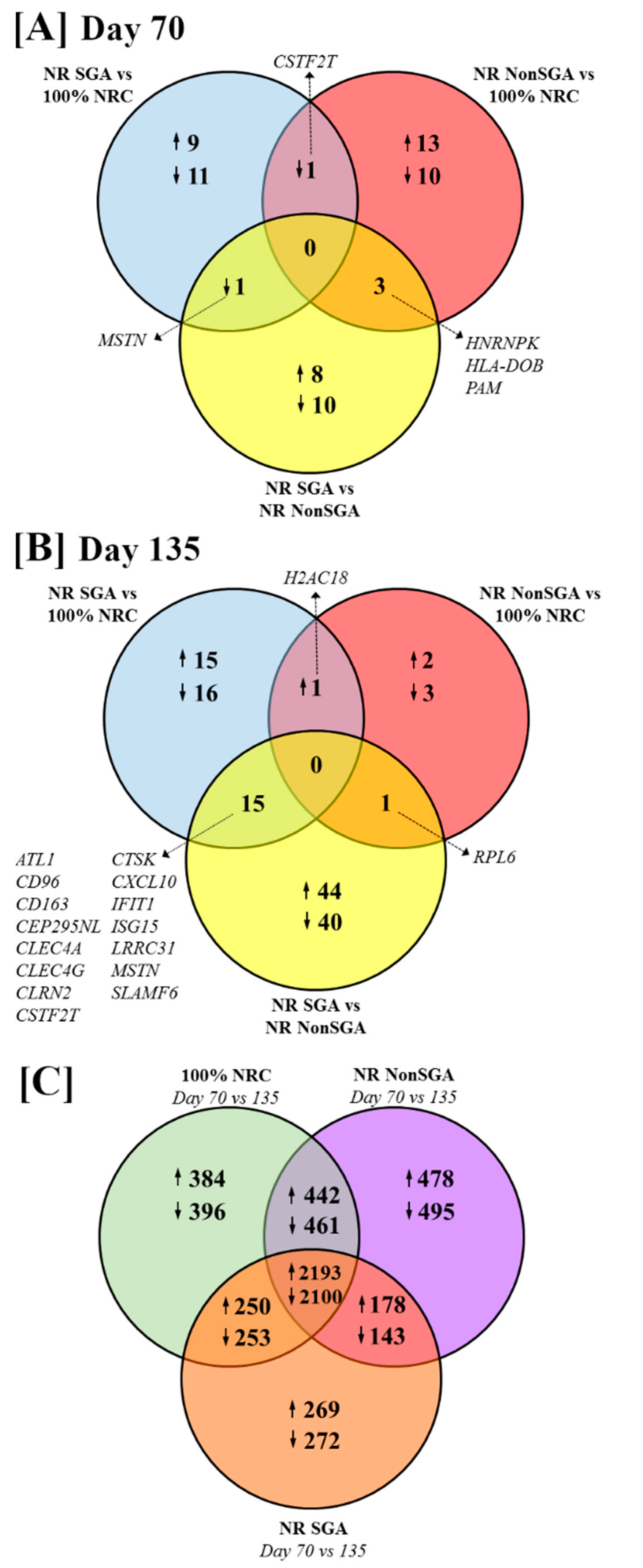

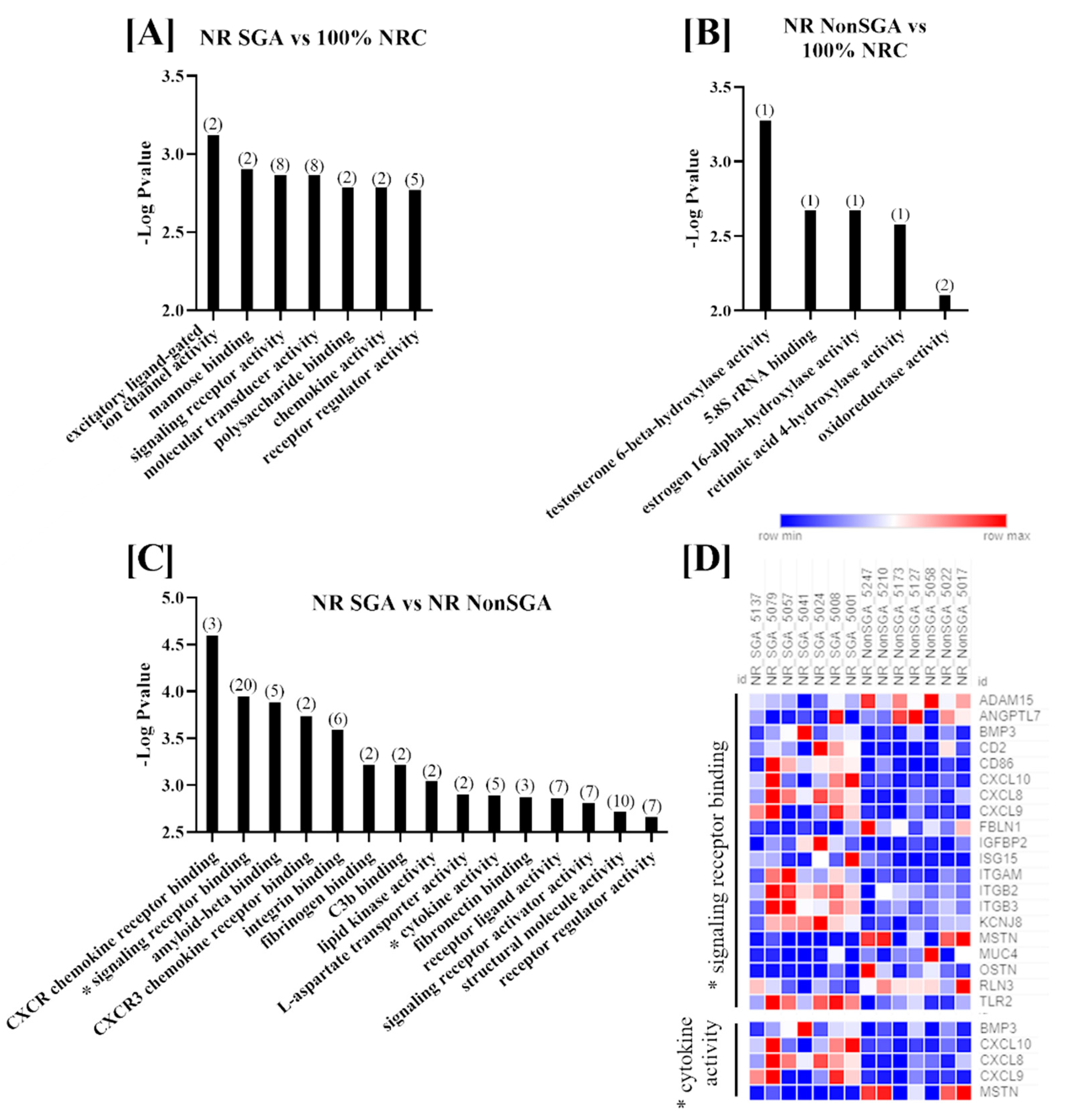
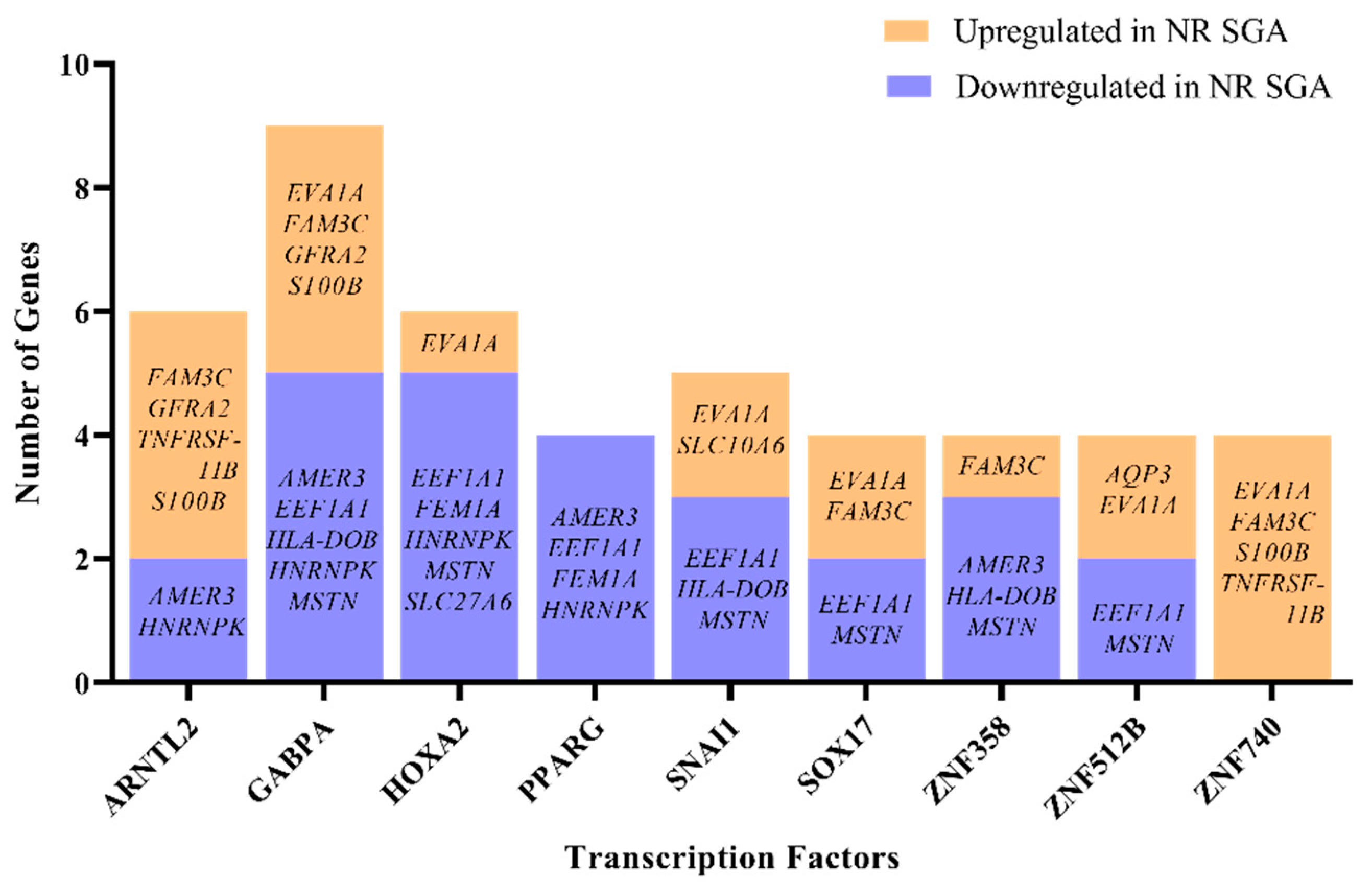
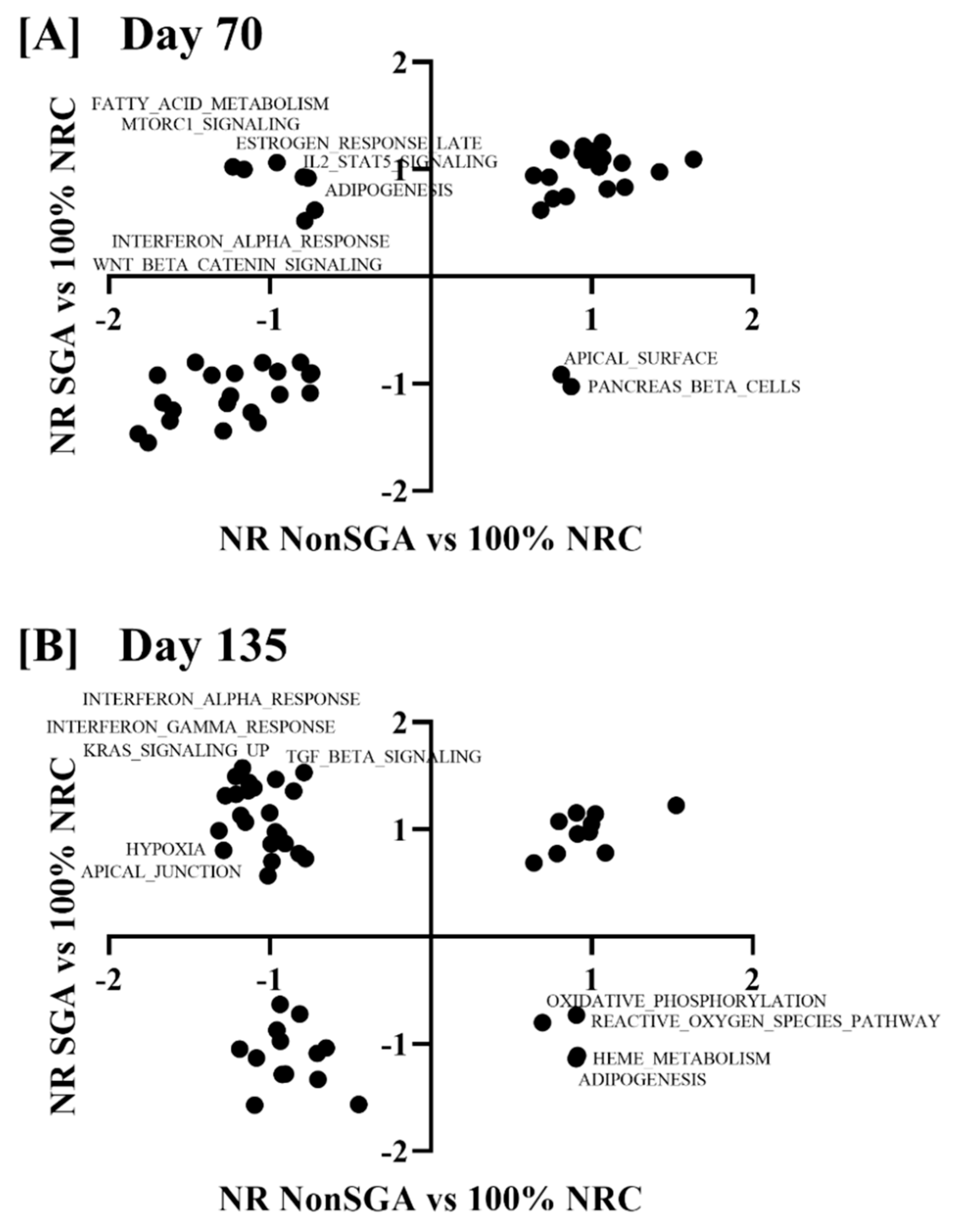
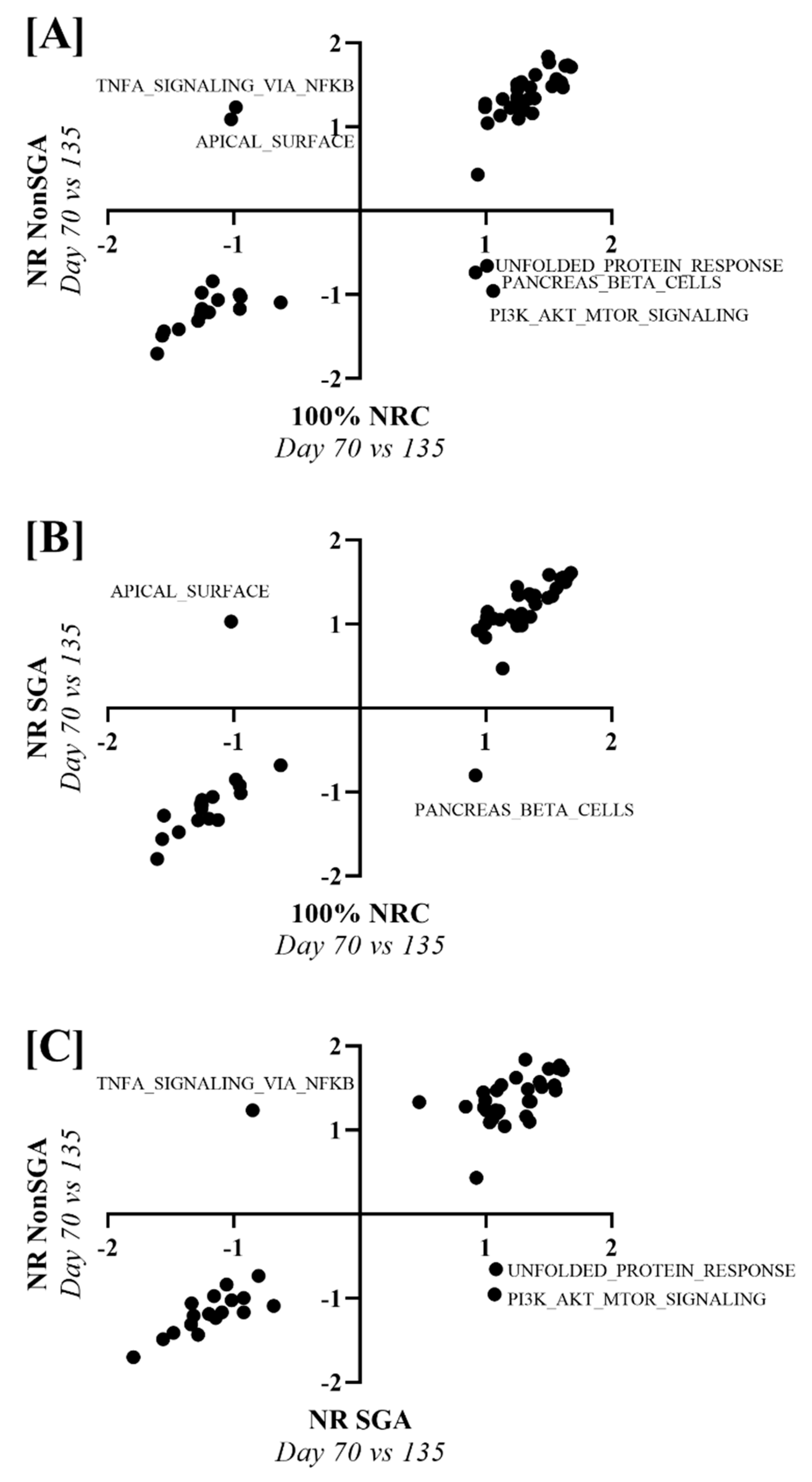

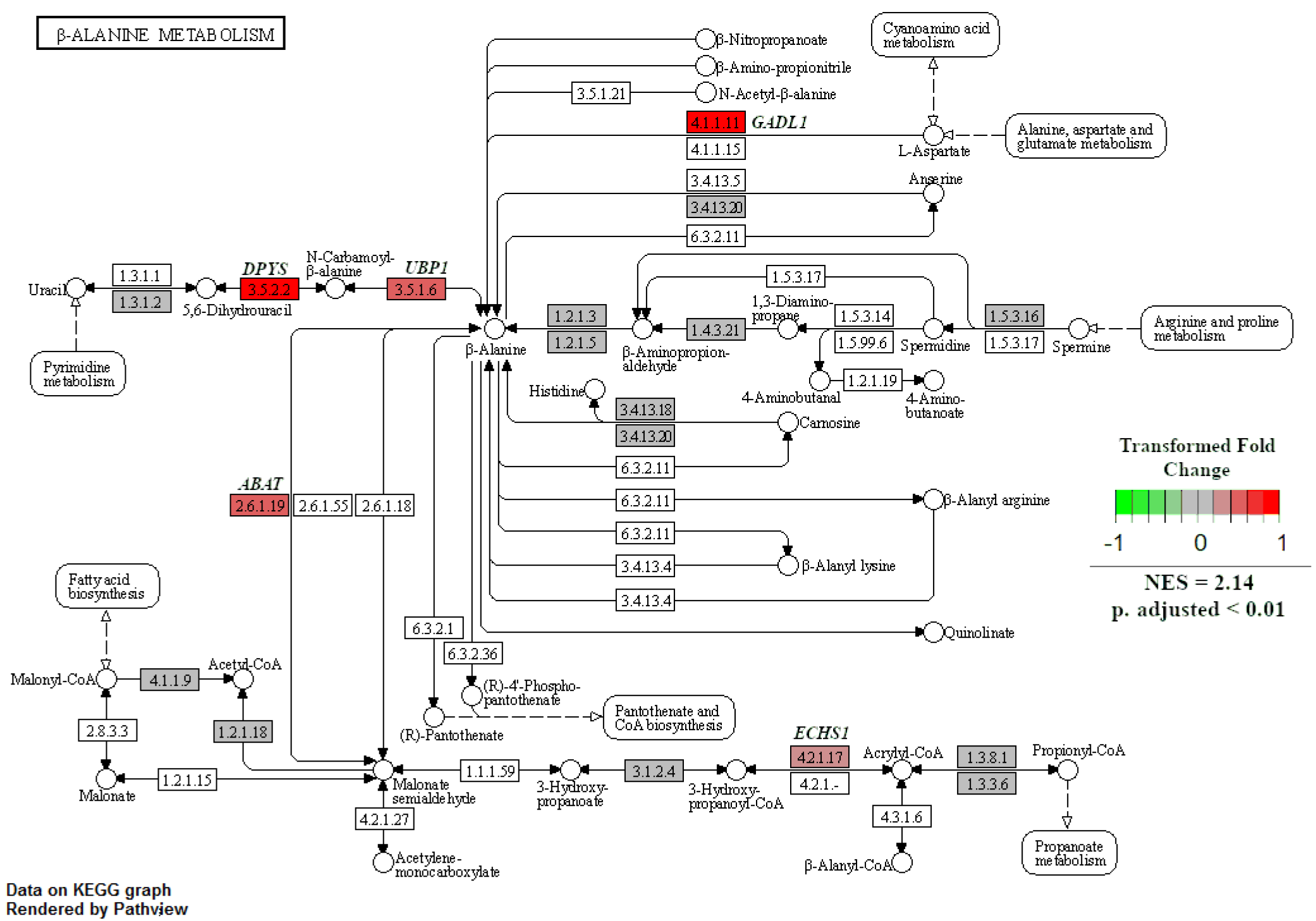
| NR SGA 1 vs. 100% NRC | NR NonSGA vs. 100% NRC | NR SGA vs. NR NonSGA | ||||||
|---|---|---|---|---|---|---|---|---|
| Gene | Log2 FC 2 | FDR 3 | Gene | Log2 FC | FDR | Gene | Log2 FC | FDR |
| MSTN | −3.10 | 0.03 | HNRNPK | −6.28 | 0.01 | HNRNPK | −5.53 | 0.02 |
| CSTF2T | −2.78 | 0.08 | UBE2D3 | −3.36 | <0.01 | MSTN | −3.74 | 0.03 |
| HLA-DQA1 | −1.98 | 0.03 | CSTF2T | −3.17 | 0.02 | FEM1A | −2.35 | 0.09 |
| SLC15A5 | −1.92 | 0.07 | GBP4 | −2.74 | 0.01 | EEF1A1 | −1.91 | 0.06 |
| COL19A1 | −1.87 | 0.01 | PPAT | −2.23 | 0.09 | AMER3 | −1.56 | 0.10 |
| IL12RB2 | −1.52 | 0.01 | OLFM1 | −1.81 | 0.09 | HLA-DOB | −1.28 | 0.07 |
| GPRIN2 | −1.12 | 0.02 | APLP1 | −1.44 | 0.01 | MUC4 | −1.14 | 0.07 |
| CD74 | −1.01 | <0.01 | HLA-DQB2 | −1.38 | 0.09 | SLC27A6 | −0.77 | 0.06 |
| FZD2 | −0.85 | 0.05 | HLA-DQA2 | −1.04 | 0.01 | WNT9B | −0.76 | 0.05 |
| MMP9 | −0.75 | 0.10 | NOTUM | −0.61 | 0.10 | JAM2 | −0.73 | 0.08 |
| PI15 | −0.73 | <0.01 | SH3GL3 | −0.44 | 0.01 | APOE | −0.67 | 0.06 |
| LRATD1 | −0.50 | 0.08 | MCM5 | −0.35 | 0.05 | PAM | −0.54 | 0.02 |
| NFE2L3 | −0.35 | 0.08 | GINS2 | 0.34 | 0.09 | FAM3C | 0.35 | 0.06 |
| THBS1 | 0.58 | 0.10 | TTC21B | 0.43 | 0.10 | ZNF462 | 0.53 | 0.04 |
| CD163 | 0.65 | 0.06 | PAM | 0.50 | 0.01 | AQP3 | 0.87 | 0.06 |
| NDUFA4L2 | 0.76 | 0.08 | JMY | 0.50 | 0.09 | S100B | 1.04 | 0.02 |
| PRSS12 | 0.82 | 0.01 | MRC1 | 0.51 | 0.03 | MYO1A | 1.28 | 0.06 |
| PLAC8L1 | 0.91 | 0.03 | RNASE1 | 0.57 | 0.09 | DOK5 | 1.31 | 0.07 |
| CACNG3 | 1.78 | 0.08 | FOLR3 | 0.60 | 0.01 | EVA1A | 1.32 | <0.01 |
| BTNL9 | 1.92 | 0.07 | FHL1 | 0.66 | 0.01 | TNFRSF11B | 2.07 | 0.06 |
| SPATS1 | 2.31 | 0.08 | SGCB | 0.67 | 0.03 | GFRA2 | 2.28 | 0.02 |
| SLC5A12 | 2.53 | 0.08 | NIPAL4 | 0.78 | 0.09 | SLC10A6 | 2.77 | 0.06 |
| ZC3HAV1L | 0.80 | 0.09 | ||||||
| SVOPL | 0.83 | 0.01 | ||||||
| HLA-DOB | 1.35 | 0.05 | ||||||
| RPL6 | 1.46 | 0.01 | ||||||
| PDE6B | 2.13 | 0.01 | ||||||
| NR SGA 1 vs. 100% NRC | NR NonSGA vs. 100% NRC | NR SGA vs. NR NonSGA Cont. | ||||||
|---|---|---|---|---|---|---|---|---|
| Gene | Log2 FC 2 | FDR 3 | Gene | Log2 FC | FDR | Gene | Log2 FC | FDR |
| CLRN2 | −3.82 | 0.04 | CYP3A5 | −3.68 | 0.04 | LPCAT4 | −0.48 | 0.02 |
| PIWIL1 | −3.34 | 0.09 | CYP3A24 | −3.36 | 0.03 | GSTA4 | −0.45 | 0.08 |
| MSTN | −3.19 | 0.10 | ARSD | −1.43 | 0.04 | IMPDH1 | −0.45 | 0.10 |
| NTNG1 | −2.85 | 0.06 | GLRX5 | 1.08 | 0.04 | ATL1 | −0.44 | 0.08 |
| CCL11 | −2.51 | 0.09 | RPL6 | 1.59 | <0.01 | ADAM15 | −0.42 | 0.10 |
| CCDC70 | −2.16 | 0.07 | DDX4 | 1.72 | 0.07 | DGKZ | −0.40 | 0.06 |
| SEMA3E | −2.06 | 0.08 | H2AC18 | 5.33 | 0.03 | LAPTM5 | 0.37 | 0.04 |
| PPIL6 | −1.65 | 0.05 | NR SGA vs. NR NonSGA | ZNFX1 | 0.39 | 0.09 | ||
| CLIC6 | −1.63 | 0.02 | CLEC1A | 0.45 | 0.03 | |||
| CAPN11 | −1.50 | 0.10 | Gene | Log2 FC | FDR | SLC38A7 | 0.47 | 0.10 |
| ANPEP | −1.17 | 0.03 | MSTN | −4.25 | <0.01 | OLA1 | 0.49 | 0.04 |
| IL1R2 | −1.11 | 0.08 | KRT4 | −3.76 | 0.06 | CTSK | 0.57 | 0.01 |
| CASQ1 | −0.99 | 0.01 | CLRN2 | −3.49 | 0.08 | TLR2 | 0.60 | 0.02 |
| SH3BP2 | −0.79 | 0.08 | MAN2B2 | −2.73 | <0.01 | KCNJ8 | 0.61 | 0.10 |
| CEP295NL | −0.78 | 0.02 | ANGPTL7 | −2.20 | 0.04 | SERPINB2 | 0.70 | 0.10 |
| ETNPPL | −0.69 | 0.02 | COL25A1 | −2.08 | 0.10 | IFI44L | 0.72 | 0.09 |
| CCDC80 | −0.67 | 0.02 | CCDC151 | −1.97 | 0.01 | ITGB2 | 0.75 | 0.04 |
| HAPLN3 | −0.64 | 0.10 | RPL6 | −1.88 | <0.01 | GALNT13 | 0.78 | 0.03 |
| ATL1 | −0.51 | 0.04 | LRIT1 | −1.80 | 0.09 | DPYD | 0.79 | 0.10 |
| CHRNE | −0.43 | 0.10 | OSTN | −1.79 | 0.02 | CYTH4 | 0.79 | 0.05 |
| CTSK | 0.54 | 0.01 | MUC4 | −1.75 | 0.07 | CD274 | 0.87 | 0.10 |
| FCGR1B | 0.73 | 0.09 | TCL1B | −1.74 | <0.01 | CMTM4 | 0.89 | 0.10 |
| UMAD1 | 0.75 | 0.06 | CCDC86 | −1.63 | 0.09 | CLEC4A | 0.92 | 0.01 |
| CLEC4A | 0.79 | 0.10 | MYOM3 | −1.33 | 0.08 | IGFBP2 | 0.96 | 0.05 |
| MAF | 0.83 | 0.09 | PCYOX1 | −1.25 | 0.01 | CLEC4G | 0.98 | 0.03 |
| COLGALT2 | 0.98 | 0.01 | ERICH4 | −1.21 | 0.10 | CD163 | 0.99 | <0.01 |
| FST | 1.01 | 0.08 | RPL30 | −1.14 | 0.06 | LRRC25 | 1.02 | 0.09 |
| CD163 | 1.02 | 0.01 | PODN | −1.11 | 0.01 | ITGB3 | 1.05 | 0.05 |
| CD200R1L | 1.03 | 0.06 | CES4A | −1.04 | 0.01 | EPHB1 | 1.09 | 0.10 |
| NRN1 | 1.09 | 0.10 | CASQ1 | −1.02 | 0.02 | GPR182 | 1.11 | 0.09 |
| CLEC4G | 1.11 | 0.02 | RLN3 | −1.00 | 0.09 | ITGAM | 1.15 | 0.01 |
| LRRC31 | 1.14 | 0.02 | CCNA1 | −0.94 | 0.05 | SLAMF6 | 1.19 | 0.08 |
| ISG15 | 1.20 | 0.10 | HSH2D | −0.94 | 0.07 | EVA1A | 1.26 | <0.01 |
| IFIT1 | 1.21 | 0.01 | CEP295NL | −0.90 | <0.01 | CD86 | 1.30 | <0.01 |
| SLAMF6 | 1.21 | 0.02 | FIG4 | −0.90 | 0.04 | LAD1 | 1.37 | 0.10 |
| EPM2A | 1.29 | 0.06 | TST | −0.89 | 0.08 | ISG15 | 1.47 | 0.04 |
| CD96 | 1.37 | 0.07 | CYP8B1 | −0.89 | 0.06 | CXCL8 | 1.47 | <0.01 |
| ERVW-1 | 1.44 | 0.06 | SLC13A3 | −0.82 | <0.01 | CXCL9 | 1.57 | 0.04 |
| P2RX2 | 1.45 | 0.04 | CLCN1 | −0.77 | 0.05 | CD2 | 1.57 | 0.08 |
| TRIML2 | 1.54 | 0.01 | A2ML1 | −0.75 | 0.02 | IFIT1 | 1.59 | <0.01 |
| SH2D2A | 2.01 | 0.07 | ADA | −0.66 | 0.06 | BMP3 | 1.69 | 0.08 |
| CXCL10 | 2.25 | 0.10 | ORAI2 | −0.65 | 0.09 | CLGN | 2.06 | 0.09 |
| ZNF623 | 3.25 | 0.01 | CRYAB | −0.64 | 0.05 | CXCL10 | 2.11 | 0.03 |
| SNX10 | 3.47 | 0.07 | NINL | −0.63 | 0.06 | CLEC4F | 2.17 | 0.09 |
| CSTF2T | 3.65 | <0.01 | AGK | −0.61 | 0.10 | CD96 | 2.49 | <0.01 |
| RPL9 | 4.37 | 0.05 | CALML5 | −0.61 | 0.03 | SAXO1 | 3.31 | 0.08 |
| H2AC18 | 5.56 | <0.01 | CLDND1 | −0.60 | 0.01 | CSTF2T | 3.36 | <0.01 |
| ART4 | −0.58 | 0.10 | CYP3A5 | 3.40 | 0.01 | |||
| OTULINL | −0.55 | 0.04 | RPL9 | 4.36 | 0.06 | |||
| CRELD2 | −0.53 | 0.04 | CCDC148 | 4.52 | <0.01 | |||
| FBLN1 | −0.51 | 0.04 | ||||||
Publisher’s Note: MDPI stays neutral with regard to jurisdictional claims in published maps and institutional affiliations. |
© 2021 by the authors. Licensee MDPI, Basel, Switzerland. This article is an open access article distributed under the terms and conditions of the Creative Commons Attribution (CC BY) license (https://creativecommons.org/licenses/by/4.0/).
Share and Cite
Steinhauser, C.B.; Lambo, C.A.; Askelson, K.; Burns, G.W.; Behura, S.K.; Spencer, T.E.; Bazer, F.W.; Satterfield, M.C. Placental Transcriptome Adaptations to Maternal Nutrient Restriction in Sheep. Int. J. Mol. Sci. 2021, 22, 7654. https://doi.org/10.3390/ijms22147654
Steinhauser CB, Lambo CA, Askelson K, Burns GW, Behura SK, Spencer TE, Bazer FW, Satterfield MC. Placental Transcriptome Adaptations to Maternal Nutrient Restriction in Sheep. International Journal of Molecular Sciences. 2021; 22(14):7654. https://doi.org/10.3390/ijms22147654
Chicago/Turabian StyleSteinhauser, Chelsie B., Colleen A. Lambo, Katharine Askelson, Gregory W. Burns, Susanta K. Behura, Thomas E. Spencer, Fuller W. Bazer, and Michael Carey Satterfield. 2021. "Placental Transcriptome Adaptations to Maternal Nutrient Restriction in Sheep" International Journal of Molecular Sciences 22, no. 14: 7654. https://doi.org/10.3390/ijms22147654
APA StyleSteinhauser, C. B., Lambo, C. A., Askelson, K., Burns, G. W., Behura, S. K., Spencer, T. E., Bazer, F. W., & Satterfield, M. C. (2021). Placental Transcriptome Adaptations to Maternal Nutrient Restriction in Sheep. International Journal of Molecular Sciences, 22(14), 7654. https://doi.org/10.3390/ijms22147654






